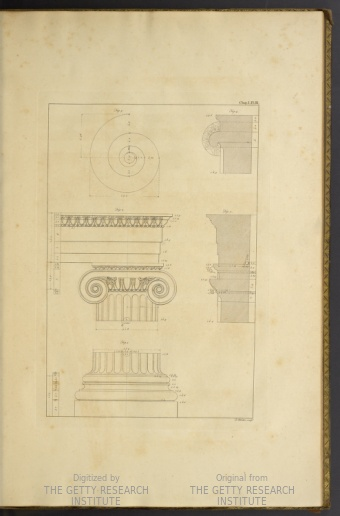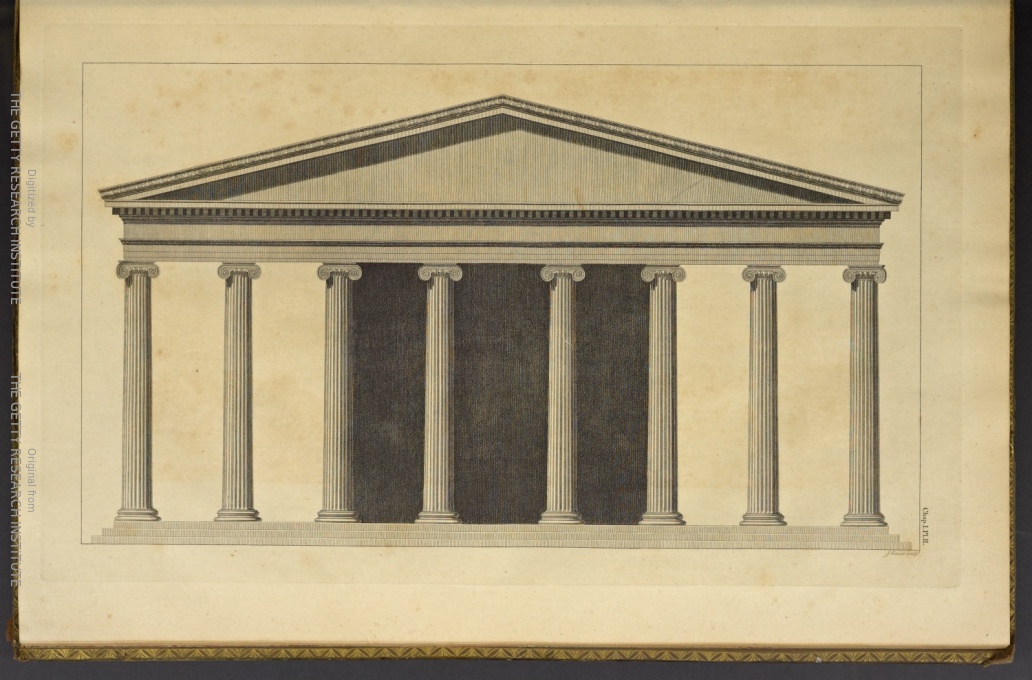It is clear that John Addington Symonds was more than inundated with images of classical-style architecture from large-form sketches to more nuanced blueprint-like drawings—images like those from the Society of Dilettanti’s Ionian Antiquities. The images pictured below display conventional elements of Classical architecture: Ionic columns, measured forms that are easy to read, golden ratio proportions, and marble construction. What is particularly interesting though is the pure volume of classical architecture and classicizing forms he was exposed to through books in his father’s collection, including not only the volumes of the Society of Dilettanti, but also illustrations by Flaxman and reproductions of Hamilton’s vase collection. In his Memoirs, Symonds gives us detailed descriptions of architecture, but upon a closer look, he rarely mentions classical architecture; the overwhelming majority of his architectural passages describe a Gothic style. So despite his early exposure to classical architecture and obvious affinity for classical Greece and antiquity why does he home in on some of the complexities and forms of Gothic architecture?


Here is Symonds’ first instance of an architectural description of a Gothic-style space. I have bolded the most salient phrase for emphasis.
The sense of meanness which annoyed me in our house, afflicted me far more keenly in the Chapel of the Blind Asylum, where we attended service twice on Sundays. The bastard Gothic lancets, dead grey, rough-cast walls and ugly painted wood-work of that paltry building gave me absolute pain. It suffocated my soul and made me loathe evangelical Protestantism. Most of all, at night, when gas-lamps flared in open jets upon the sordid scene, I felt defrauded of some dimly apprehended birthright. (Memoirs, p. 67)
Laden with negative words to describe Gothic forms, Symonds refers to the Gothic lancets as “bastard,” augments the color grey to “dead grey,” and inconspicuously calls the painted wood-work “ugly,” saying it gave him pain. Symonds lays it out for us in his line condemning soul-suffocating evangelical Protestantism. These recollections belong to a young Symonds most likely under ten years old. At this point in his childhood, we know his relationship with God is similar to superstition more than piety.
So I kept perpetually mumbling: ‘Oh, God, save me from the cholera!’ This superstitious habit clung to me for years. I believe that it obstructed the growth of sound ideas upon religion; but I cannot say that I ever was sincerely pious, or ever realized the language about God I heard and parroted. (Memoirs, p. 69)
As Ellen Harty points out in a 2019 blog post, Symonds would have had exposure to some disturbing depictions of hell as a child, possibly adding to his negative perception of Church services, and, transitively, Gothic architecture. Symonds makes his divisive relationship with God evident in his writings as well.
In a dim way I felt God more. But I did not learn to fling the arms of soul in faith upon the cross of Christ. That was not in me. And it would be unfair to expect from any sacrament of the church that it should work a miracle on catechumens. (Memoirs, p. 141)
Employing no effort to hide his distaste, Symonds continuously takes opportunities within his Memoirs to point out his dislike of Gothic architecture. In the quote below you can see how he perceives Gothic-revival as tacky.
In those days Clifton must have been beautiful and wild indeed. The few houses of the gentry clustered around the humble village church— not that ugly building which now perpetuates the bad taste of the incipient Gothic revival, and the dismal piety of the Simeon trustees—but a rustic West of England chapel, with narrow windows and low sloping roof. (Memoirs, p. 107)
From these examples, it is easy to assume a connection between the drab yet imposing Gothic architecture that Symonds perceives and his negative feelings about going to Church as a child, but as we look at more of his architectural descriptions, we can see a much more complex relationship.
Because his youth meditations on the Gothic style are related to churches, at first it seems that the church is the object that fuels his contempt for Gothic. But one instance at the Bristol Cathedral, originally a Gothic church with Gothic revival editions in the 19th century, Symonds viewpoint radically changes. In the quote below Symonds has recently been “awoken” by the concepts of love in Plato’s Phaedrus and Symposium and is about to be charmed by his first love Willie Dyer.
On the first Sunday morning after my arrival, I attended service in Bristol Cathedral. It was a radiant forenoon, and the light streamed in from those large southern windows. My ritualistic pranks with Vickers at Harrow had this much of reality in them, that they indicated a natural susceptibility to the aesthetic side of religion—I felt a real affection and natural reverence for grey Gothic churches. The painted glass and heraldries in this cathedral, crusaders cross-legged on their tombs, carved woodwork and high-built organ lofts, the monuments to folk long dead, and, over all, the quiring voices and reverberations of sweet sacred music, touched me to the quick at a thousand sensitive points. There was no real piety, however, in my mood. My soul was lodged in Hellas; and the Christian in me stirred only, like a torpid snake, sunned by the genial warmth of art. (Memoirs, p. 155)
Symond’s newly found reverence for the Gothic comes at a point in his life when he “was on the verge of attaining to a man’s self-consciousness.” When meditating on his relationship with Willie he realizes that
In [Willie] too I found the final satisfaction of that dim aesthetic ecstasy which I called religion. Music and the grandeur of Gothic aisles, the mystery of winter evenings in cathedral choirs, when the tumultuous vibrations of the organ shook the giant windows and made the candles in their sconces tremble, took from him a poetry that pierced into my heart and marrow. (Memoirs, p. 156)
I would argue that this is the turning point in his life where not only has he accepted Gothic architecture as a noble and reverent form, but in a less superficial way, he begins to understand the Gothic style as more than just imposing forms. About ten years later, Symonds comes to a realization while reflecting on the music in the presence of sacred architecture and explaining that a cathedral without music to fill the space with “invisible presences” makes the architecture seem dead and cold (Memoirs, p. 288).
The church of St Ouen might be almost called provokingly perfect: a full-sized, elaborately designed Gothic cathedral, finished on one plan down to its minutest details. Some of the romance of old church-building is lost by this completeness. The precise way in which it has been isolated from surrounding houses and planted at one end with pleasant trees, destroys the pathos of the picturesque. Nothing is left to the imagination. But for gaining an insight into the working of the medieval brains which planned these structures, St Ouen is invaluable. Here the veriest child can see that the spirit of Gothic art is not anarchy, but symmetry and order. Only the parts here forced into correspondence are almost infinite; not, as in the case of Greek work, select and few. (Memoirs, p. 289)
Symonds completely flips his perception of Gothic architecture throughout his life concluding that the inherent spirit of Gothic architecture is in the symmetry and order of its forms. From this point on, Symond’s descriptions and meditations on Gothic architecture are generally positive. He calls out fine distinctions between different regions’ Gothic styles telling us that he finds the early pointed style more tasteful than the later iterations of Gothic (decorated style). And from here, his descriptions of Gothic become nothing less than poetic. For example:
On a second visit to the cathedral, by dint of staying there in quiet thought for two hours, I harmonized my mind to its severe and heaven-aspiring beauty. This church has the bloom and freshness of adolescence; the strength of the old Norman with the delicacy and luxuriant loveliness of early Gothic. The huge round arches of the nave are adorned with diapers and traceries, not yet formed into flowers or foliage, but rich like gured brocades. The transept and the choir expand into the beauty of clustered columns, soaring to a vast height and feathering with fantastic leafage, while the long pointed windows of clerestory and chapel hold wheels, cut into hexagons and quatrefoils by pure crisp cusps, the very models of expanded summer blossoms. (Memoirs, p. 294).
Symond’s fascinating relationship with the Gothic poses many questions. There is a clear turning point where Symonds is touched by religion, love, and the Gothic architecture he once felt a bold distaste for. So why are all these different aspects of Symonds’ psyche connected? It is interesting to think about his childhood exposure of Gothic style juxtaposed with the overwhelmingly classical collection of his father’s library. Perhaps Symonds’ notion of the visual culture of antiquity holds a different place in his mind compared to the emotional and religious sacredness of the Gothic that he only first realizes when he feels his first romantic connection. It is possible that his romanticizing of Gothic architecture after his “awakening” and encounter with Willie Dyer in the Bristol Cathedral positively paints his perception of Gothic architecture allowing him to not only see the beauty in the physical forms, but the more sacrosanct nature of Gothic’s symmetry and order.
While it seems at first that Symond’s childhood distaste of the Gothic comes from a dislike of church, his early relationship with the style could easily be attributed to a lack of exposure. Regardless, it is noticeable that the further Symonds gets from his childhood, his father’s library, and the classical imagery on which he would place great academic value, the more he experiences the profound nature of the Gothic style and the more he comes to revere it in a manner that goes deeper than purely taste or preference for form and style.
Works cited:
Symonds, John Addington, and Amber K Regis. The Memoirs of John Addington Symonds : a Critical Edition. London: Palgrave Macmillan, 2016.
Chandler, Richard, Nicholas Revett, and William Pars. Ionian Antiqvities. London: Printed by T. Spilsbury and W. Haskell, 1769.

